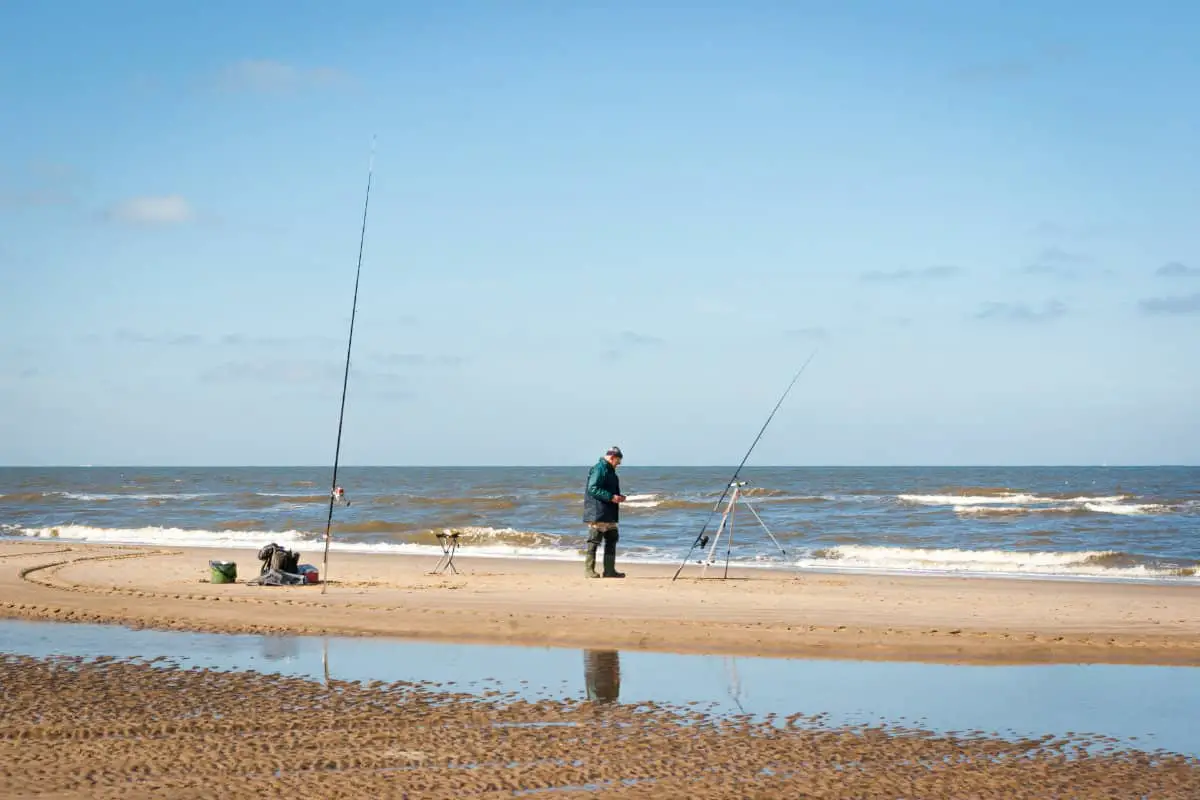Surf fishing is a popular sport along coastal beaches around the world. The rules of surf fishing differ from place to place and change throughout the year. The California coastline is a popular destination for surf anglers and has a specific set of regulations in place.
Some of California’s surf fishing rules include a fishing license requirement for anyone over the age of 16 unless you’re fishing on a public pier. Other important rules include finfish only being taken by hand or by angling and required report cards for certain fish species.
To learn more about the above rules, and what other regulations California has about surf fishing, read on. We will also explore the basics of surf fishing and what you can expect to catch in California.
What Is Surf Fishing?
Surf fishing is the sport of catching any kind of fish, mollusk, invertebrate, amphibian or crustacean, while positioned on or near the shoreline. Most of the time, it refers to saltwater fishing and is extremely popular throughout the world.
In general, fishing is the second most popular outdoor activity![]() in the US, second only to running. In 2017, almost 50 million people participated in various types of sport fishing.
in the US, second only to running. In 2017, almost 50 million people participated in various types of sport fishing.
In particular, the US has a penchant for surf fishing![]() , with some of the best spots in beautiful locations like Oahu, Hawaii, the Outer Banks of North Carolina, Long Islands, Montauk, Massachusetts, and all up and down the coast of California.
, with some of the best spots in beautiful locations like Oahu, Hawaii, the Outer Banks of North Carolina, Long Islands, Montauk, Massachusetts, and all up and down the coast of California.
Surf fishing uses a combination of tools and techniques to “take” fish. These include lines from rods cast from shore, nets, and traps set for crustaceans, and even digging by hand. Other tools include spears, spearguns, shovels, harpoons, slurp guns, and bows and arrows.
Where and when you can use these accessories changes depending on what type of fish you are taking and what part of California you are in. We will explore these tools and the rules around them in depth a bit later.
Surf Fishing in California: Everything You Need To Know
So, what can you expect from surf fishing in California![]() ? A wide variety of meaty fish, with generous laws when it comes to quantities and low-cost licenses.
? A wide variety of meaty fish, with generous laws when it comes to quantities and low-cost licenses.
With a year-round open season and two days of the year where anyone can fish anywhere- even those without a license, surf fishing in California is easy to get into.
Some of the most common and delicious species of fish caught in California include:
- Rockfish
- Cabezon
- Giant Kelpfish
- Kelp Greenling
- Kelp Bass
- Opaleye
- Sargo
- Sculpin
- California Halibut
- Pacific Halibut
- California Lizardfish
- Round Stingray
- Surf Perches

- Striped bass

- Jack Smelt
- Spiny Dogfish
Anyone Can Fish From a Pier
One of the most important things to note about surf fishing in California is that fishing licenses are not required if you are fishing from a public pier.
This is defined as a structure extending into the water from the mainland, above the high tide level, that has been created or currently functions for the purpose of fishing.
Piers on private property do not count as public places, and you will require a license to fish from them.
As long as access to the pier is not restricted to the public, then anyone can fish from it. Seabreaks, or a man-made outward landmass that has been built to protect an ocean harbor, also count as public piers.
Note that they must be the most seaward protective boundary or this consideration does not apply.
The amount of lines you can use while fishing from a public pier![]() is two. This includes any variation of fishing equipment. You can mix and combine the use of rod and lines, hand lines, nets, or traps, as long as the total tools you are using are no greater than two.
is two. This includes any variation of fishing equipment. You can mix and combine the use of rod and lines, hand lines, nets, or traps, as long as the total tools you are using are no greater than two.
It is important to note that if you are fishing from a pier, and you do not have a fishing license, you may not leave the pier in the process of catching a fish.
For example, you cannot hook a fish, then walk back onto the beach to help land it. You can potentially be fined for this, as you would need a license to fish from the beach.
It is also important to note that in two California areas, namely between Golden Gate Bridge and the west Carquinez Bridge in the San Francisco area, you may only use one line with no more than three hooks.
Even though fishing from a pier does not require a fishing license, the other fishing rules still apply. These include species restrictions, minimum size measurements, and seasonal fish restrictions.
Be sure to check the regulations in the area that you plan to fish, which can differ along the coast.
You May Not Take a Crustacean by Hook and Line Method
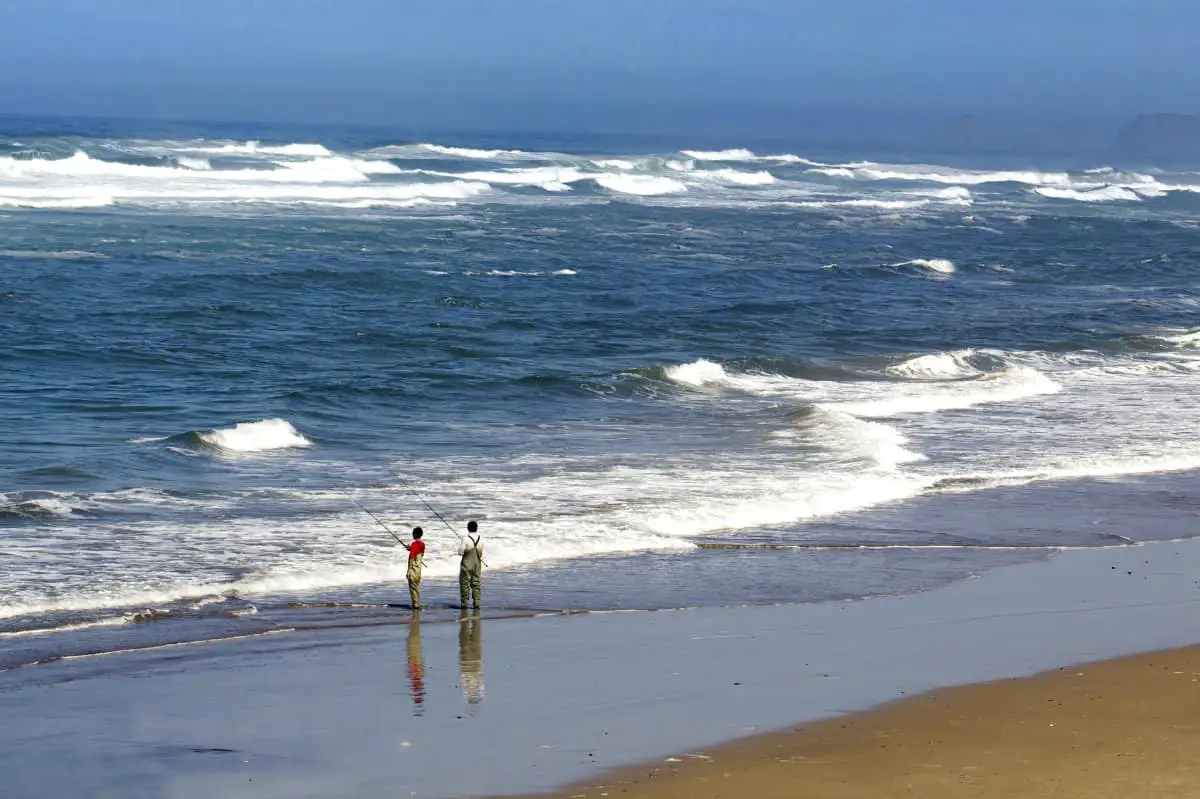
Certain rules apply to crustaceans that don’t apply to other kinds of sea creatures that you may take.
A crustacean may not be taken by a hook and line method, regardless of where you’re fishing. If a crustacean is caught by the hook and line method, it must be returned to the water immediately.
Crustaceans may be taken by hand, so physically grabbing the crustacean in a dive is acceptable. There are hand tools that are also acceptable to be used in crustacean fishing. These include spades, shovels, hoes, and rakes.
The most common way of taking crustaceans is through a trap system. These have their own rules as well.
You may not move, disturb, or damage any trap. You cannot take any crustaceans from anyone else’s trap- unless you have written permission and the GO ID number (Game and Wildlife account number) of the owner on your person.
Hoop traps and crab traps are allowed to be used. Crab traps must have a “destruct device” of a piece of cotton that the trap releases when it disintegrates. This is in case you abandon your trap; it does not keep crustaceans locked inside.
Shrimp and prawn traps may catch shrimp and prawns only. To ensure this, the openings for these traps may be no larger than ½ an inch.
No Selling of Fish With a Sport License
Once you obtain your license and go surf fishing, you must be sure that you are not tempted to sell your catch. It is illegal to sell, buy, trade, or barter for any fish caught with a sport license.
If you would like to sell your fish, then you will be required to obtain a commercial license. This comes with its own rules and regulations like where and how you can fish.
Report Cards
Report cards are needed to fish for certain types of sea animals. They must be filled out and returned to specific locations by a certain date. They must also be on your persons as you are fishing for that specific type of fish.
If you don’t return your report card by a certain date, you may not be administered another card the following year.
Report cards are required by anyone fishing these specific types of fish, whether or not you are under 16, or fishing on a public pier, or fishing on a no license day.
Below are some of the report cards and costs required in the state of California for surf fishing:
| Title | Fee | Details |
| Steelhead Report Card | $7.82 | Necessary for anyone fishing for steelhead in inland waters. |
| Sturgeon Fishing Report Card | $8.90 | Necessary for anyone fishing for sturgeon. Only one of this Report Card will be given to each person per year. |
| North Coast Salmon Report Card | $7.05 | Necessary for anyone fishing for salmon in the Klamath-Trinity River System and/or Smith River System.. |
| Abalone Report Card | $24.33 | Only one Abalone Report Card will be given to each person per license year. |
| Spiny Lobster Report Card (valid for the whole lobster season). | $10.29 | Necessary for anyone wanting to take spiny lobster. |
Source: California Department of Fish and Wildlife
Have Your Fishing License on You All The Time
You are also required to carry your fishing license on you while you are fishing. It was previously required to display your license while you fish, but now it can be stored.
Fish Limits
There are certain limits for how many fish you can take in a given day. The daily bag and possession limit for RGC fish is 10. You can mix and match the species, including rockfish, cabezon, kelp, and rock greenlings.
Lingcod![]() is limited to two fish per person, and leopard sharks are limited to three fish per person.
is limited to two fish per person, and leopard sharks are limited to three fish per person.
Petrale sole, starry flounders, and pacific sanddabs, and other flatfish have no limit in size or number.
In some areas, ocean whitefish are limited to 10 per person, while California sheepshead are capped at five. California scorpionfish are also stopped at five, and soupfin shark is a very small one fish per person.
These numbers may vary from area to area of the California coastline, and some species may be more or less restricted at certain times of the year. If you are uncertain, call your local branch of the Fish and Wildlife Department of California![]() to get the most up to date information before you fish.
to get the most up to date information before you fish.
Certain Fish Must Not Be Caught
Some fishes are not allowed to be taken, anytime of year and by any person. These include:
- Bronzespotted Rockfish
- Cowcod
- Yelloweye Rockfish
- Steelhead Rainbow Trout
- Coho Salmon
- Green Sturgeon
- Grunion
There are also fish that go through very important closed fishing seasons. These currently include Dungeness crab![]() and red abalone. The reasons for these closed fishing seasons can vary depending on the mating needs of fish, or the success of fish farming the previous year.
and red abalone. The reasons for these closed fishing seasons can vary depending on the mating needs of fish, or the success of fish farming the previous year.
Approved and Disallowed Baits
Rules also apply to the bait that you use when surf fishing![]() in California.
in California.
Chumming is the act of throwing bait into the water to attract animals. This is often used to attract sharks![]() to near boats as they are extremely sensitive to the smell of flesh in the ocean. Chumming is allowed in California, including the use of live bait.
to near boats as they are extremely sensitive to the smell of flesh in the ocean. Chumming is allowed in California, including the use of live bait.
Tilapia, a type of smaller white fish, may not be used as live bait in ocean waters off the California coast.
There are also rules against using any substance or material that may be damaging to fish and/or wildlife, according to Fish and Game Code, section 5650.
Equipment for California Surf Fishing
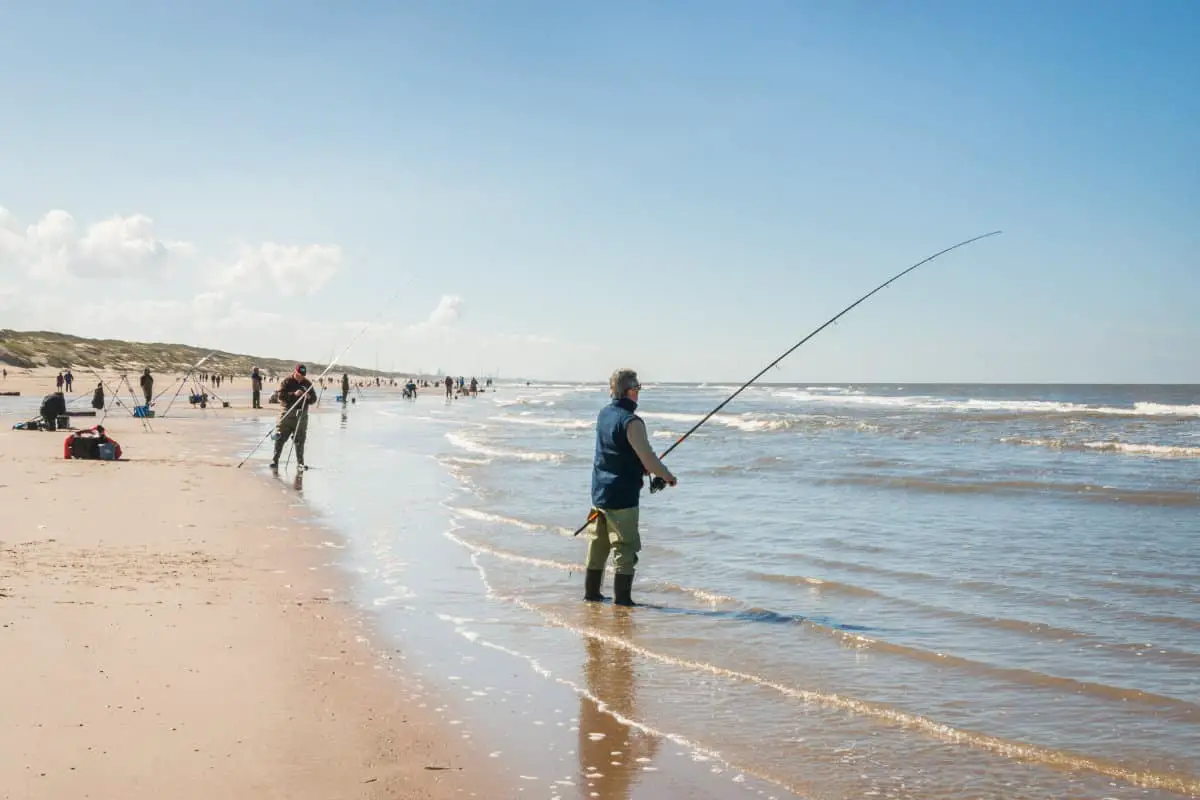
As with every other aspect of surf fishing in California, the California Department of Fish and Wildlife![]() has to approve the gear you use.
has to approve the gear you use.
Hooks and Lines
Finfish can be caught on a hook and line or by hand. There is no limit on the number of hooks and lines that can be used throughout the coast except for the following areas:
- North of Point Conception. You may only use one rod and a single line when trying to catch salmon or any salmon on board or in local possession by the fisherman.
- San Francisco Bay. Only one line with three hooks may be used.
- No gaff hooks. In short, you may not use a hook to help land a fish in any other way than the fish voluntarily taking the hook in its mouth. You may not stab or harm a fish with a hook in your hand to help lift the fish ashore, or onto your boat.
- Public piers. Only two rods and lines, a pair hand lines, or a couple of (2) nets or traps may be used.
Hawaiian Throw Nets or Dip Nets
The following species may be taken with dip nets throughout the California coast:
- Herring
- Surf Smelt
- Shiner Surfperch
- Squid
- Shrimp
- Topsmelt
- Anchovies
- Pacific Staghorn Sculpin
If you are north of Point Conception, you can use Hawaiian throw nets to capture these same species as well.
Beach Nets
North of Point Conception, beach nets that are not greater in length than 20 feet may be used. The diameter of the mesh of these nets must be 7/8ths of an inch or larger.
Diving and Spearfishing
Spearfishing is allowed throughout California and is one of the best ways to feel rewarded when you sit down to enjoy your meal. Spearfishing consists of fishing without bait, using only physical force to pierce your prey.
Some people still use muscle-powered spears, basically like tossing a javelin in the water to stab the fish. You can do this along shorelines, standing on the beach, or a rocky outcropping.
You can also do this off of a boat. Freedivers, snorkelers, and scuba divers all spearfish in California.
The other option for spearfishing is a spear gun. These are gun-shaped tools that use rubber bands or pneumatic systems to launch a spear at a fish when fired.
Both handheld spears and spearguns are legal in California, but some rules surround their use.
You may not have or utilize a spear if you are in the 100-yard vicinity of the stream’s mouth in the ocean north of Ventura County. You also may not use a spear to take any of the following types of fish:
- Broadbill (aka Swordfish)
- Broomtail Grouper
- Garibaldi
- Giant Black Sea Bass
- Gulf Grouper
- Salmon
- Trout
Slurp Guns
Slurp guns are almost too aptly named. They are a tube-like gun that extends into the water, but instead of shooting, it pulls inward. Yes, it slurps up the fish live, into the tube.
These are most often used in tropical places to capture colorful fish for home aquariums. They also offer a no-harm way to perform the much-debated catch and release fishing.
Slurp guns are a great way to introduce your children to fishing and teach them about different species as you capture and view them in the gun.
Slurp guns are allowed in the state of California. The only stipulations are that they may not be used to capture any fish with a minimum size requirement, and the total of the fish held may not exceed standard bag limitations.
Spears, Harpoons, Bow, and Arrows
All of the above equipment is legal in California. Be sure that you don’t carry any of these things when you are closer than 100 yards to a stream, or in water that lies north of Ventura County.
All of the above tools may be used to take skates, rays, and sharks, except for white sharks.
Bow and arrows can be used to take finfish, other than the following:
- Broadbill (aka Swordfish)
- Broomtail Grouper
- Garibaldi
- Giant Black Sea bass
- Salmon
- Trout
- White Sharks
Cost of Fishing Licenses
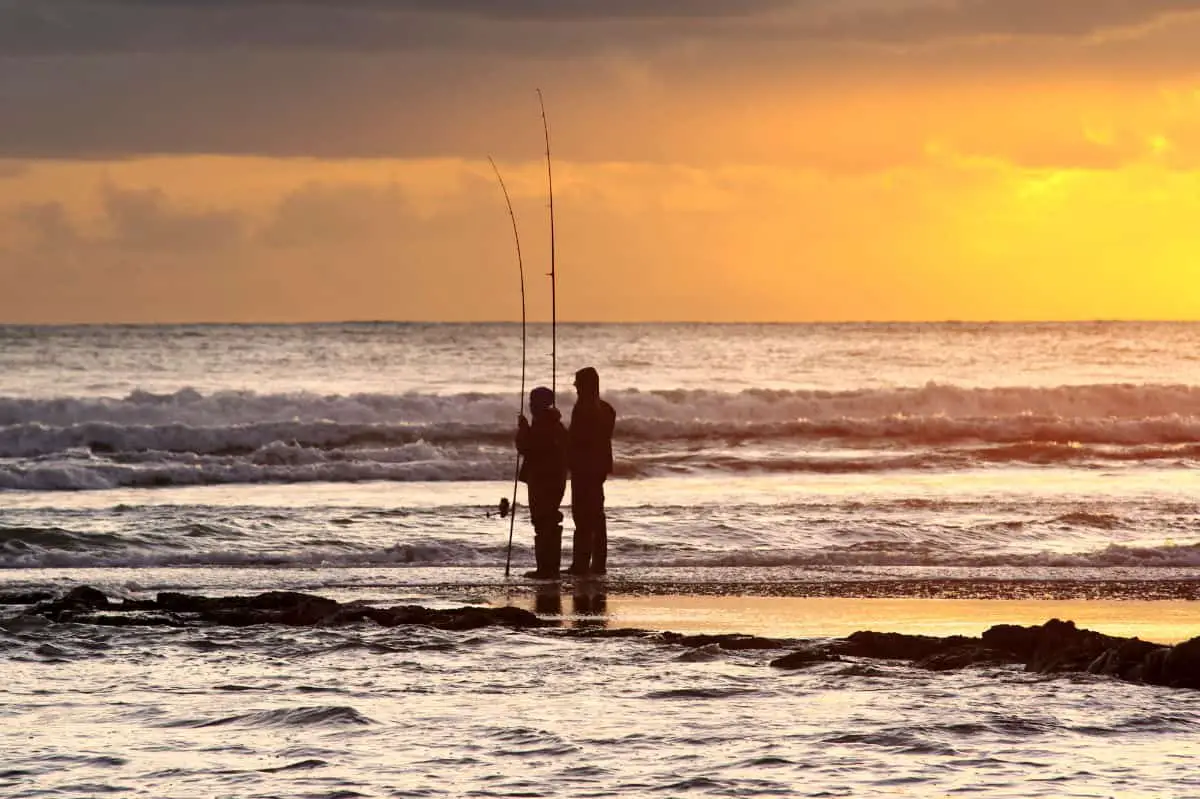
There are various types of fishing licenses in California, depending on your needs. If you are looking for a single day license or are not a resident, your license will vary.
The cost of fishing licenses in California are as follows: (all prices in USD)
| Duration of License | Type of License | Price of License |
| One year | Resident Sport Fishing | $51.02 |
| One year | Non-Resident Sport Fishing | $137.73 |
| One year | Reduced-Fee Sport Fishing License – Disabled Veteran | $8.13 |
| One year | Reduced-Fee Sport Fishing License – Recovering Service Member | $8.13 |
| One year | Reduced Fee Sport Fishing License – Low Income Senior | $7.73 |
| One year | Free Sport Fishing License – Low Income Native American | FREE |
| One year | Free Sport Fishing License – Mobility Impaired, Blind or Developmentally Disabled | FREE |
| Single Day | Sport Fishing License | $16.46 |
| Two Day | Sport Fishing License | $25.66 |
| 10 Day | Non-Resident Sport Fishing License | $51.02 |
| Lifetime License | Age 0-9 | $562.25 |
| Lifetime License | Age 10-39 | $919.00 |
| Lifetime License | Age 40-61 | $828.00 |
| Lifetime License | Age 62+ | $562.25 |
| Lifetime License | Fishing Privilege Package: a Lifetime Second-Rod Stamp, Ocean Enhancement Stamp, North Coast Salmon Report Card and Steelhead Report Card | $380.25 |
Free Fish Days
To encourage people to try fishing and encourage those who may have not fished in a while and don’t currently hold a fishing license, California hosts two open fishing days a year.
Anyone can fish without a license during these days, and they are not restricted to a public pier.
The size, bag, and method regulations must still be obeyed, and scorecards must still be obtained for specific fish species, but no fishing license is required. For 2020 the dates of these free fishing days are July 4th and September 5th.
What Are the Differences in Surf Fishing Rules and Regulations between California and Texas?
Surf fishing rules and regulations differ between California and Texas. In California, anglers need a fishing license and are subject to bag limits. In Texas, a license is also required, along with adherence to specific size limits for catches. For more information, check out some Texas surf fishing tips.
Frequently Asked Questions About Surf Fishing in California
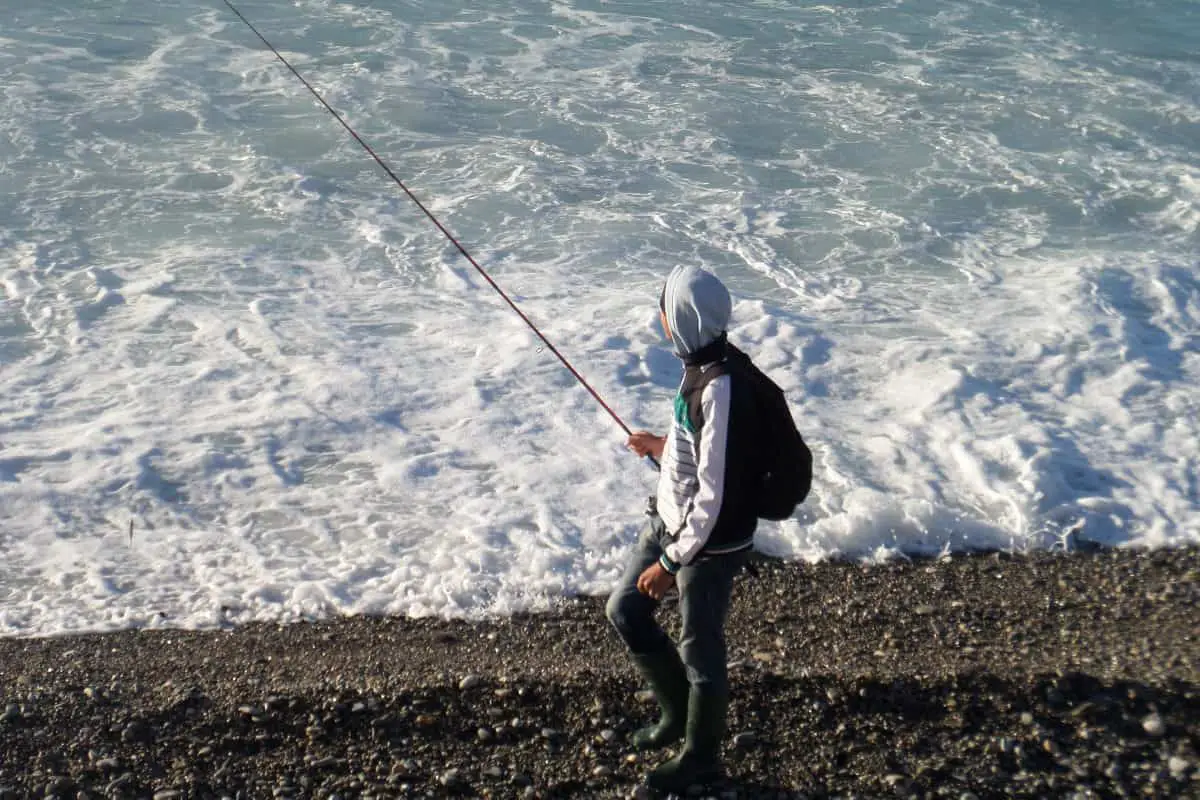
Q: Is an Ocean Enhancement Stamp required to fish from a dock?
A: No, this is a stamp meant for ocean fishing in the waters south of Point Arguello, where anglers must also have a fishing license. It is not required to fish from a pier.
Q: If I hook a fish on the pier, can I walk down to the shore to land it?
A: Yes, and no. As discussed earlier in this article, you cannot leave the pier to land the fish if you do not have a fishing license. Since a fishing license is required everywhere in California except for a public pier, this includes the beach around the pier. Those with a fishing license may do so but should have their license on them to avoid a fine.
Q: If I’m fishing from a pier, how many rods can I use?
A: When fishing throughout the coast, you may use no more than two rods, a pair of hand lines, or a couple (2) of nets or traps for crustaceans. You may mix these tools as long as you are never exceeding more than two appliances at one time.
Q: Can I bring more than two rods, nets, or lines with me onto the pier?
A: Yes, you may have more than two of each of these things with you on the pier, as long as you are not using more than two at a time.
Q: Can I use both of my rods and lines to fish for salmon from the pier?
A: No. Only one rod can be used to catch salmon in Californian ocean waters, regardless of location.
Q: If I catch a crab or lobster with my hook and line, can I keep it?
A: Unfortunately, no. It is illegal to take crustaceans by the hook and line approach. You must instead release the animal immediately. The only legal method of taking these crustaceans is by hoop net, crab traps, or crab snares. This applies to Dungeness crabs![]() as well, when they are in season.
as well, when they are in season.
Q: What gear should I bring with me to go surf fishing?
A: As far as fishing goes, it’s your preferred method that will dictate what gear you use. Beginners are recommended to start with one rod and one line, though they may want to bring a crab trap as well.
Other gear that may be of use:
- Cooler for fish caught
- A tape measure to ensure fish are to size
- Pliers to remove hooks from fish (needle nose are best)
- Tackle and bait
Q: What should I wear to go surf fishing?
A: Since the temperatures of California’s coastline can range widely from night to day, it’s recommended to bring layers, a wool sweater, and long pants are preferable in the early morning hours.
If you plan on wading, then you’ll need waders and should also wear a U.S. Coast Guard-approved personal flotation device.
Mostly though, your concerns should be of protection from the long times in the sun. A brimmed hat and suntan lotion will protect your body from burning, while polarized eyesight will defend your vision and help you spot fish in the surf.
Q: What is the best time of day to go surf fishing![]() ?
?
A: The time of day that you will most likely catch the most fish is about an hour before dusk, or in the early hours of the morning (dawn).
You can also go throughout the day, but try and time your casts with high-tide or mild to moderate surf levels. When the tide rolls in, it forces tiny fish movement in sandbars that encourage the bigger fish to feed. They are most likely to go for your line at this time.
Q: What is the best time of the year to fish from the pier in Central California?
A: This depends on what type of fish you are hoping to catch. Take a look at the chart below for some peak months of popular species of fish.
| Surfperch | Striped Bass | California Halibut | Jacksmelt | Night/ Surf Smelt |
| October – June | April – September | May – August | April – August | February – August |
Q: What is the best time of year to fish from a pier in Southern California?
A: Like Central California, this depends on what you are hoping to catch. Here is another chart specific to popular fish in Southern California.
| Surfperch | Yellowfin Croaker | Spotfin Croaker | California Corbina | California Halibut |
| September – May | June – September | July – September | July – September | June – October |
Summary
As we can see, surf fishing in California is no light topic. Over a hundred pages of rules are listed in the “California Oceans Sport Fishing Regulations![]() ” information guide. These rules and regulations are extensive and are always changing throughout the seasons and from year to year.
” information guide. These rules and regulations are extensive and are always changing throughout the seasons and from year to year.
Some of the most important rules include required licenses for anyone over 16 who is not fishing on a public pier, size and species regulations, and the ban of sale or barter for any sport-acquired fish.

